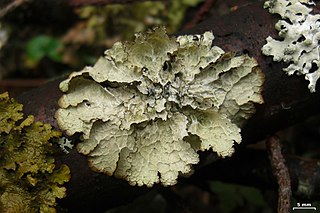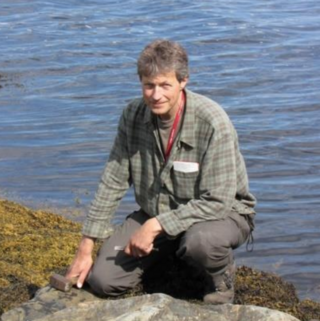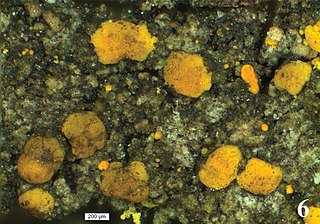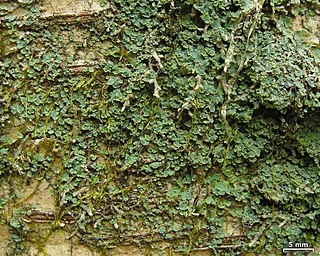
Verrucariaceae is a family of lichens and a few non-lichenised fungi in the order Verrucariales. The lichens have a wide variety of thallus forms, from crustose (crust-like) to foliose (bushy) and squamulose (scaly). Most of them grow on land, some in freshwater and a few in the sea. Many are free-living but there are some species that are parasites on other lichens, while one marine species always lives together with a leafy green alga.
Clavascidium is a genus of lichens in the family Verrucariaceae. The genus was circumscribed in 1996 by Austrian lichenologist Othmar Breuss. Because the type species of the genus, Clavascidium umbrinum, has been shown using molecular phylogenetics to belong to genus Placidium, Cécile Gueidan and colleagues proposed to unite Clavascidium with Placidium in a 2009 publication. Despite this, the genus has been retained in recent publications of fungal classification.

Placidium is a genus of crustose to squamulose to almost foliose lichens. The genus is in the family Verrucariaceae. Most members grow on soil, but some grow on rock (saxicolous). The fruiting bodies are perithecia, flask-like structures immersed in the lichen body (thallus) with only the top opening visible, dotting the thallus. Lichen spot tests are all negative. Members of the genus lack rhizines, but otherwise resemble members of the genus Clavascidium.

Lichens are symbiotic organisms made up of multiple species: a fungus, one or more photobionts and sometimes a yeast. They are regularly grouped by their external appearance – a characteristic known as their growth form. This form, which is based on the appearance of vegetative part of the lichen, varies depending on the species and the environmental conditions it faces. Those who study lichens (lichenologists) have described a dozen of these forms: areolate, byssoid, calicioid, cladoniform, crustose, filamentous, foliose, fruticose, gelatinous, leprose, placoidioid and squamulose. Traditionally, crustose (flat), foliose (leafy) and fruticose (shrubby) are considered to be the three main forms. In addition to these more formalised, traditional growth types, there are a handful of informal types named for their resemblance to the lichens of specific genera. These include alectorioid, catapyrenioid, cetrarioid, hypogymnioid, parmelioid and usneoid.
Parmeliella triptophylloides is a species of corticolous (bark-dwelling) lichen in the family Pannariaceae. Found in east Africa, it was formally described as a new species in 2003 by Norwegian lichenologist Per Magnus Jørgensen. The type specimen was collected by Dutch mycologist Rudolf Arnold Maas Geesteranus in 1949, from the Cherang'any Hills at an elevation of 900 m (3,000 ft). In addition to the type locality, it has also been recorded from the Luhangalo Plateau in Tanzania.
Candelariella corallizoides is a species of squamulose (scaley), saxicolous (rock-dwelling) lichen in the family Candelariaceae. Found in Mexico, it was formally described as a new species in 2007 by Swedish lichenologist Martin Westberg. The type specimen was collected from the north-facing cliffs of the Sierra Agua Verde at an elevation of 1,200 m (3,900 ft). Here, in open oak woodland with shrubs, it was found growing on siliceous rock. The lichen is known to occur in several localities in Baja California. The specific epithet corallizoides refers to the coralloid squamules of the thallus.
Candelariella complanata is a species of squamulose (scaley) and saxicolous (rock-dwelling) lichen in the family Candelariaceae. Found in southwestern North America, it was formally described as a new species in 2007 by Swedish lichenologist Martin Westberg. The type specimen was collected from a cliff of the Sierra Agua Verde at an elevation of about 1,000 m (3,300 ft); here it was found growing on volcanic rock. The thallus of the lichen is complanate (smooth) as a result of its flattened and peltate squamules. This gives it a distinct appearance that is referenced in the specific epithet complanata. The geographic range of Candelariella complanata includes Baja California, Coahuila, Sinaloa, and Sonora, north to southern Arizona, Texas, and New Mexico. It prefers to grow on siliceous rock in open montane habitats to elevations of at least 1,900 m (6,200 ft).
Waynea cretica is a species of corticolous (bark-dwelling), squamulose lichen in the family Ramalinaceae. It occurs on the Greek island of Crete and in Portugal.

Catapyrenium boccanum is a species of squamulose (scaley), rock-dwelling lichen in the family Verrucariaceae. It grows on mortar or on calcareous rock. Its squamules are up to 4 mm wide, pale to dark brown with black margins and a black underside. Ascospores measure 11–15 by 5–8 μm. Because of its combination of squamulose thallus, simple ascospores, and lack of algae in the hymenium, this species is a "catapyrenioid" lichen, of which more than 80 exist in the Verrucariaceae.
Clavascidium sinense is a species of squamulose (scaley), ground-dwelling lichen in the family Verrucariaceae. Found in Northwest China, it was formally described as a new species in 2022 by Tingting Zhang and Xinli Wei. The type specimen was collected in Datong City at an altitude of 1,147 m (3,763 ft). The species epithet sinense refers to its Chinese distribution.

Agonimia octospora is a species of corticolous, (bark-dwelling) squamulose (scaly) lichen in the family Verrucariaceae. It was formally described as a new species in 1978 by the lichenologists Brian John Coppins and Peter Wilfred James. The type specimen was collected in Glengarriff Forest in (West Cork, where it was found growing on the bark of oak. Characteristics of the lichen include its colourless ascospores that number eight per ascus, and its tiny squamules that are closely attached to its substrate. Its spores typically measure 60–75 by 20–26 μm. The lichen is found in Europe and South America.

Platismatia tuckermanii is a species of corticolous (bark-dwelling), foliose lichen in the family Parmeliaceae. It is endemic to Eastern North America and is distinguished by its broad, loosely attached lobes and primarily sexual reproduction.
Krogia microphylla is a rare species of corticolous (bark-dwelling), squamulose (scaley) lichen in the family Ramalinaceae. Found in the Dominican Republic, it was formally described as a new species in 2011 by lichenologist Einar Timdal. The type specimen was collected from a cloud forest in El Seibo Province at an altitude of about 450 m (1,480 ft). It is only known from the type collection. The species epithet refers to the tiny squamules that make up the thallus.
Fuscopannaria dissecta is a species of corticolous (bark-dwelling), squamulose lichen in the family Pannariaceae. Found in Japan, it was formally described as a new species in 2000 by Norwegian lichenologist Per Magnus Jørgensen. The type specimen was collected by Syo Kurokawa from Mount Kōya at an altitude of 800 m (2,600 ft); there it was found growing on the rotting bark of trees. The lichen has a pale brown thallus that forms irregular patches comprising squamules that about are about 2 mm wide. The squamules are dissected–cut deeply into fine lobes–and it is this character that is referenced in the species epithet dissecta.

Fuscopannaria leucosticta, commonly known as the rimmed shingle lichen, is a species of lichen in the family Pannariaceae. It has a squamulose (scaley) thallus that lacks soredia and isidia, but has abundant apothecia with distinct white rims. Although its main centres of distribution are eastern North America and southeast Asia, where it grows in damp forests, it has been reported from various other high-altitude, humid locations.
Phlyctis monosperma is a species of corticolous (bark-dwelling), crustose lichen in the family Phlyctidaceae. It is characterised by its greyish-white, loose, granular thallus, single-spored asci, and distinctive chemical substances. The lichen is found in the subtropical evergreen forests of the Eastern Himalayas and Western Ghats of India, where it grows on rough tree bark in close association with plant-dwelling bryophytes at elevations above 2,000 m (6,600 ft). It also occurs in Sri Lanka.

Alan Orange was a British lichenologist. His research interests included lichen taxonomy and phylogenetics, aquatic lichens, and the family Verrucariaceae.

Protocandelariella is a genus of lichen-forming fungi in the family Candelariaceae. It has two species of squamulose (scaley), corticolous (bark-dwelling) lichens.

Normandina pulchella, commonly known as the elf-ear lichen or blue heart, is a species of squamulose lichen in the family Verrucariaceae. This cosmopolitan species is widely distributed across both hemispheres, where it thrives in moist microhabitats. It favours moss-covered deciduous trees and rocks, often colonising over mosses and bryophytes. It occasionally grows on bare bark and on other lichens. Distinctive features of N. pulchella include its bluish-green squamules (scales) with sharply raised margins, non-reactivity to standard chemical spot tests, and growth in humid habitats. Initially, Nannochloris normandinae, a green alga, was thought to be its photobiont. However, recent studies have revised this understanding, now suggesting Diplosphaera as the algal partner.
Knightiellastrum is a single-species fungal genus in the family Icmadophilaceae. This monotypic genus the contains the corticolous (bark-dwelling), squamulose lichen species Knightiellastrum eucalypti, found in Tasmania, Australia.











